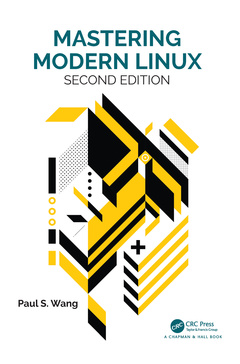Description
Mastering Modern Linux (2nd Ed.)
Language: English
Subjects for Mastering Modern Linux:
Keywords
Linux System; Terminal Window; operating systems; Int Argc; Unix; Linux Distribution; networking; IP Address; C programming; Const Char; cloud computing; Command Line Arguments; Paul S; Wang; Linux File System; Current Working Directory; Int Fd; Web Server; Full Pathname; Parent Process; PHP Code; Struct Sockaddr; Socket Address; Datagram Socket; PHP Script; Shell Script; Root Window; Address Space; Bash Script; Stream Socket; Grep Command; File Browser
Publication date: 06-2018
· 17.8x25.4 cm · Hardback
Publication date: 06-2018
· 17.8x25.4 cm · Paperback
Description
/li>Contents
/li>Biography
/li>
Praise for the First Edition:
"This outstanding book ? gives the reader robust concepts and implementable knowledge of this environment. Graphical user interface (GUI)-based users and developers do not get short shrift, despite the command-line interface?s (CLI) full-power treatment. ? Every programmer should read the introduction?s Unix/Linux philosophy section. ? This authoritative and exceptionally well-constructed book has my highest recommendation. It will repay careful and recursive study."
--Computing Reviews, August 2011
Mastering Modern Linux, Second Edition retains much of the good material from the previous edition, with extensive updates and new topics added. The book provides a comprehensive and up-to-date guide to Linux concepts, usage, and programming. The text helps the reader master Linux with a well-selected set of topics, and encourages hands-on practice.
The first part of the textbook covers interactive use of Linux via the Graphical User Interface (GUI) and the Command-Line Interface (CLI), including comprehensive treatmentof the Gnome desktop and the Bash Shell. Using different apps, commands and filters, building pipelines, and matching patterns with regular expressions are major focuses.
Next comes Bash scripting, file system structure, organization, and usage. The following chapters present networking, the Internet and the Web, data encryption, basic system admin, as well as Web hosting. The Linux Apache MySQL/MariaDB PHP (LAMP) Web hosting combination is also presented in depth.
In the last part of the book, attention is turned to C-level programming. Topics covered include the
C compiler, preprocessor, debugger, I/O, file manipulation, process control, inter-process communication, and networking.
The book includes many examples and complete programs ready to download and run. A summary and exercises of varying degrees of difficulty can be found at the end of each chapter. A companion website (http://mml.sofpower.com) provides appendices, information updates, an example code package, and other resources for instructors, as well as students.
1. A Linux Primer 2. The Desktop Environment 3. Interacting with the BASH Shell 4. Putting Commands and Applications to Use 5. Writing BASH Scripts 6. The File System 7. Networking, Internet, and the Web 8. Basic System Administration 9. Web Hosting: Apache, PHP, and MySQL 10. C Programming in Linux 11. I/O and Process Control System Calls 12. Inter-process and Network Communication Appendices Online Website and Example Code Package
Paul S. Wang has a Ph.D. from MIT. He is professor of computer science and a well- established book author. To date, he has published 12 CS textbooks (three with CRC; Mastering Linux, Dynamic Web Programming and HTML5 and From Computing to Computational Thinking ) and all of them successful and well-received in the US and world-wide. Several books have been translated into other languages.
These books may interest you

Linux with Operating System Concepts 250.90 €



